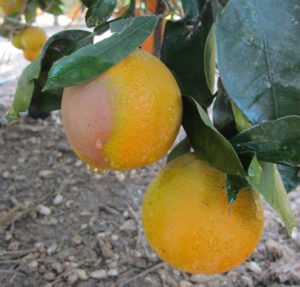
Two years ago, citrus growers in the United States received a new tool in the fight against brown rot (Phytophthora spp.) thanks to the collaboration of researchers and the IR-4 Project. Now, work is underway to approve this tool for international use, improving trade for citrus growers.
Brown rot of citrus is a problem in shipping and storage where it can be carried on infected, symptomless fruit and then quickly spread to healthy fruit. In addition to being an effective tool against brown rot, mandipropamid (marketed by Syngenta as Revus®) reduces the need for growers to apply copper fungicides to their citrus crops. It also reduces the likelihood of resistance to other fungicides.
Approval of Mandipropamid for Use on Citrus Crops
Dr. Jim Adaskaveg, a professor in the Department of Microbiology and Plant Pathology at the University of California, Riverside, identified mandipropamid as an effective fungicide against brown rot on citrus crops compared to other registered products. Adaskaveg approached the IR-4 Project in 2013 with a request to further research the fungicide’s use on orange, lemon, and grapefruit. Stakeholders nominated this as a high priority at the 2013 Food Use Workshop and IR-4 initiated residue studies in 2014. After two years of trials, data from these studies was submitted to the U.S. Environmental Protection Agency (EPA) in 2017. The EPA approved the new use of mandipropamid on citrus crops in 2019 and the California Department of Pesticide Regulation approved the registration in 2020. View our previous story for more information on the need for this approval.
Paving the Path for Global Exports
Now that mandipropamid has been approved for use on citrus crops in the U.S., work is underway to obtain an international Maximum Residue Limit (MRL) on the fungicide so that citrus crops treated with it can be exported to other countries. An MRL is the maximum amount of pesticide residue that is legally tolerated on food crops when applied correctly.
Improving the ability to trade crops internationally through the harmonization of MRLs is a priority for the IR-4 Project. For this reason, the Minor Use Foundation was established in 2018 with the mission of expanding and harmonizing international MRLs to break down trade barriers for agricultural products.
“Harmonization of MRLs globally is of great value to growers exporting from the U.S.,” said Dr Dirk Drost, Chair of the Minor Use Foundation. “Especially for citrus, which is a huge export crop. The establishment of international MRLs for mandipropamid on citrus is a great example of how partnering with IR-4, agricultural researchers and trade organizations like the California Citrus Quality Council (CCQC) can not only bring new tools to growers, but can also smooth the path for exports.”
“We owe a lot to Jim [Adaskaveg] for doing a lot of the heavy lifting with the research and to IR-4 for listing mandipropamid as a priority material to go through the program,” said CCQC President Jim Cranney. “MRLs are approved now in Japan, and hopefully we will have them established in Codex, as well.”
One way to achieve MRLs across multiple countries is by obtaining a Codex MRL. Codex is a joint initiative between the Food and Agriculture Organization (FAO) and the World Health Organization (WHO) to establish international standards for trade in food products including fruits and vegetables. The Codex Committee on Pesticide Residues, composed of more than 100 countries, meets annually to review and approve MRLs. Many countries defer to Codex MRLs rather than conducting residue studies. Therefore, obtaining a Codex MRL is an important step in global trade.
“Codex MRLs are an international standard that any country around the world can use if they want to regulate pesticide levels for products that are coming into their country,” Cranney says. “When we pack a container and ship it to another market, we want to know when it’s received there that the fruit is going to be legal and meet the regulations in the country we’re sending it to. Codex MRLs are acknowledged as a strong international standard, so when you get a Codex MRL, it has a lot of credibility.”
Approximately 25% of U.S. citrus fruit is exported each year, much of it to Asia, Cranney says. Many countries in Asia default to Codex MRLs, which is why it’s important to obtain a Codex MRL for mandipropamid on citrus.
Mandipropamid will be an important tool that growers can use to control certain species of Phytophthora. which is required for fruit exports to China. Dr. Adaskaveg has been researching additional tools (e.g., oxathiapiprolin and fluopicolide) that citrus growers can use to avoid an overreliance on copper applications and meet export demands in China.
Mandipropamid MRLs on citrus are under review by Codex at the time of this publication.
The Work is Worth It
All the work is worth it because growers have a new, effective tool that reduces economic loss, reduces the number of copper applications, and eases citrus exports between the U.S. and importing countries.
“Most growers don’t see what goes on behind the scenes in the regulatory process, but this is one of the most important aspects of the story,” Cranney says. “IR-4 is kind of an unsung hero, because they are always operating in the background. They really play an extremely important role in helping the industry get these materials registered for us, so growers have access to them.”
“Growers have a lot on their minds besides producing the commodity,” Drost says. “I’m thrilled they have a new tool available that allows them to export their crops with confidence. This is a great example of how we can work together to harmonize international trade – in this case for a huge export crop from the U.S.”
